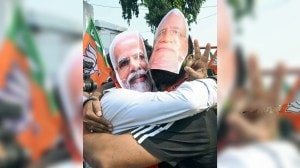Ranji’s Irish Innings
IT’S a marvel Bollywood hasn’t caught up with this script: Indian prince, loved by the British, buys Irish castle, makes annual vi...

IT’S a marvel Bollywood hasn’t caught up with this script: Indian prince, loved by the British, buys Irish castle, makes annual visits en famille and girlfriend in tow, becomes Local Hero by creating jobs for all. All this played out in the often violent backdrop of two freedom movements, of Ireland and India.
This is the extraordinary, little-known story of Ranji, Maharajah of Connemara. Not the hotel down south, of course, but the Irish sea town after which it was named. That’s where Ballynahinch Castle is located, and that is where Ranji spent the last eight summers of his life, from 1924.
By the early 1920s, Ranji’s cricketing days were well behind him. Now the Jam Saheb of Nawanagar — installed after protracted legal complications — began his second career, of statesman-diplomat, representing India at the various councils and committees that had sprung up post-World War I. It was at one of these meetings of the League of Nations in Geneva that Ranji met Irish leader W.T. Cosgrave, a president of that country. A firm friendship developed, one which made Ranji aware of the charms of Ireland and the Irish, a simpler, more blunt, friendly people than the English.
Ranji already had a long-established residence in England that became the scene of his lavish parties, its opulence a magnet to guests who had no intentions of leaving — and safe in the knowledge their host was too polite to show them the door. Ranji’s finances were already stretched, thanks to his princely weakness for the finest things in life, and even he realised it couldn’t go on. Ergo Connemara, on the western tip of Ireland, overlooking the Atlantic, a place where few would venture unless invited (and as unlike arid, dusty, Jamnagar as possible).
One of the more fascinating aspects of this story is the inherent contradiction: Ranji, Empire man to the last, darling of the British aristocracy as much for his sublime cricket as for his lineage, living in an Ireland steeped in anti-British sentiment and struggling with its own fledgling independence. In truth, India did have close links with the Irish (Annie Besant being among the more well-known) but these stemmed from their common hatred of their rulers.
Ranji could, then, have stood out like a sore thumb in deepest Ireland, especially given his lavish ways. But here’s where his diplomacy, presence of mind and genuine good nature came in handy; he was as adroit at managing contradictions as he was gliding the ball fine to the boundary.
He won over the village folk by employing them on his estate; he won over the clergy with lavish, yet thoughtful, gifts (a car, for example, in this remote countryside). On one occasion, he wished to end his birthday dinner with his usual toast to the King. Aware this might ruffle feathers, he changed tack at the last minute: ‘‘Gentlemen, we have a custom in the country from which I come, one very precious to me. I want you to stand and drink to the health of the Emperor of India.’’ His guests, not immediately identifying the one with the other, concurred readily.
For Ranji, Ballynahinch provided an escape from the rigours and stresses of running a state almost perennially on the verge of bankruptcy. Its streams, rich in trout and salmon, gave Ranji the chance to recover his sporting streak. His cricketing days were cut short following the loss of an eye in a shooting accident; angling — a sport in which he could spend hours on end —profited from use of the supple wrists that invented the leg-glance.
His castle was also the place where he could bring his companion, known only as ‘‘Mrs Williams’’. Little is known about her (which is good news for aforementioned Bollywood scriptwriters) save that she was much younger than his earlier companion, Edith Borissow, that their affair lasted 13 years and that he seemed genuinely happy in her company.
An interesting read, then, but the book comes with several caveats. One, it is not intended for an Indian readership, it deals with the freedom movement in the manner of a Class X textbook. Nor one familiar with Ranji’s cricketing exploits: the first one-third of the book details his cricket, which could have been trimmed to a large extent. This paperback edition omits the photographs which appear to be there in the original, a pity because they would have added much to the tale.
Finally, and this is the saddest part, there isn’t enough about the story at hand. Chambers gets lost in detail about India, about Ranji’s many legal battles, about the politics of the time. Well edited, this could have been a five-page magazine story. A pity, because she is an expert on this part of Ireland.
Then again, whatever are Bollywood scripwriters for?



- 01
- 02
- 03
- 04
- 05




























